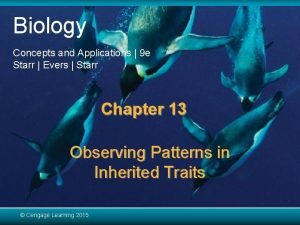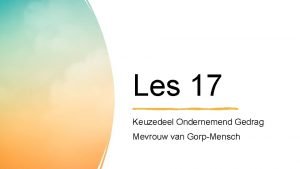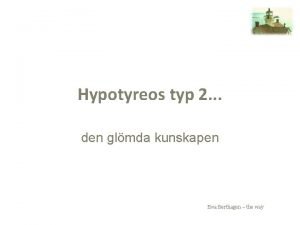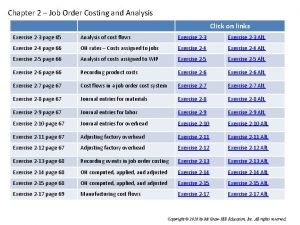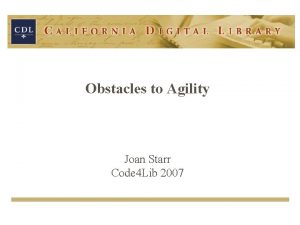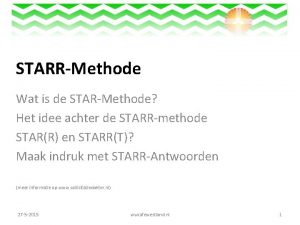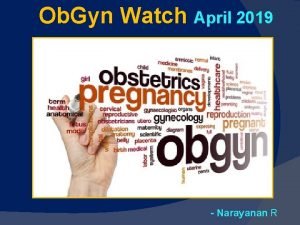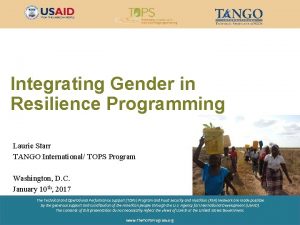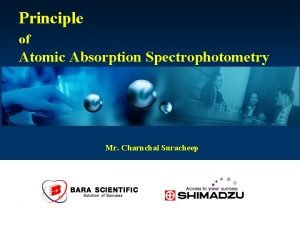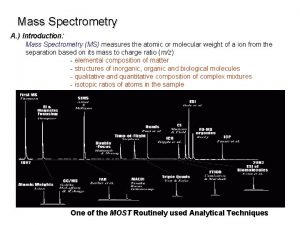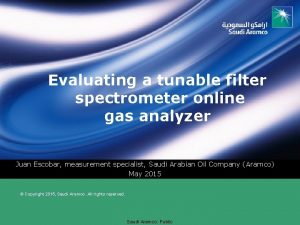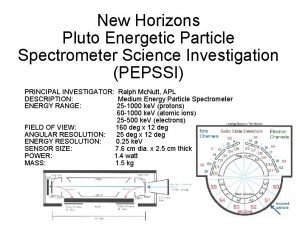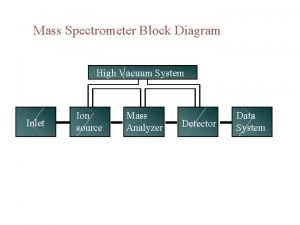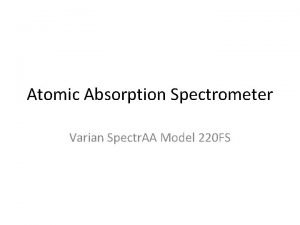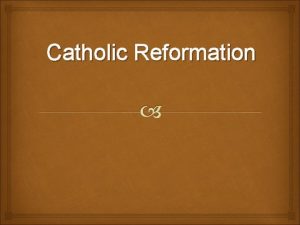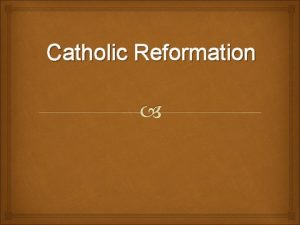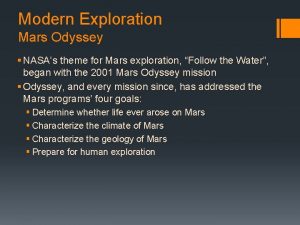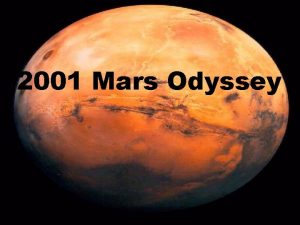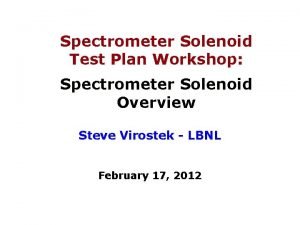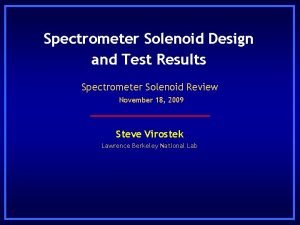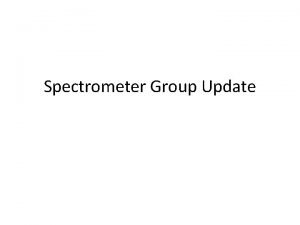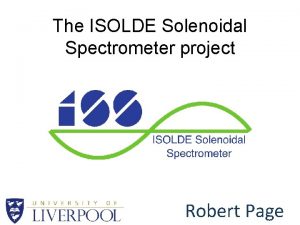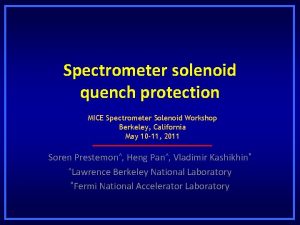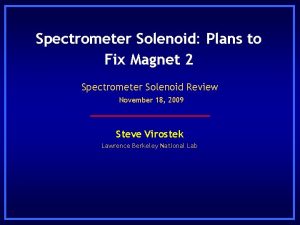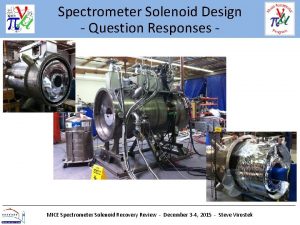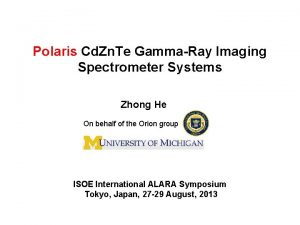Mars Odyssey GammaRay Spectrometer Richard Starr NASAGSFC Catholic

















- Slides: 17

Mars Odyssey Gamma-Ray Spectrometer Richard Starr NASA/GSFC – Catholic University and the GRS team HEND Workshop 2002 May 20 th – 22 nd 2002 2001 Mars Odyssey GRS RDS 1

Mars Odyssey GRS Timeline • • • 2001 April 07 – Launch 2001 June – 7 day warm anneal (~42° C) 2001 June 27 – Begin cruise data collection 2001 August 30 – End cruise data collection 2001 October 23 – Mars orbit insertion 2002 February 09 – Begin mapping phase 2002 March – 10 day warm anneal (~52° C) 2002 March 26 – Resume mapping 2002 May – 10 day hot anneal (~73° C) 2002 May 21 – Resume mapping 2002 June 04 – Boom deployment HEND Workshop 2002 May 20 th – 22 nd 2002 2001 Mars Odyssey GRS RDS 2

Gamma-Ray Spectrometer The Mars Odyssey gammaray spectrometer is a 67 mm diameter × 67 mm long, high -purity, n-type Ge crystal that is encapsulated in a sealed titanium canister. The detector is passively cooled to cryogenic temperatures (<130 K). HEND Workshop 2002 May 20 th – 22 nd 2002 2001 Mars Odyssey GRS RDS 3

Ge vs. Na. I HEND Workshop 2002 May 20 th – 22 nd 2002 2001 Mars Odyssey GRS RDS 4

GRS Accumulation Times The gamma-ray signal comes from the upper 20 to 30 cm of soil. Thermal and epithermal neutrons are sensitive to composition about a factor of 2 or 3 deeper than gamma rays. HEND Workshop 2002 May 20 th – 22 nd 2002 2001 Mars Odyssey GRS RDS 5

GRS Coverage HEND Workshop 2002 May 20 th – 22 nd 2002 2001 Mars Odyssey GRS RDS 6

Cruise Spectrum HEND Workshop 2002 May 20 th – 22 nd 2002 2001 Mars Odyssey GRS RDS 7

Background Lines Over 100 background lines have been identified. The intensity of many will be reduced after boom deployment. Others, resulting from detector materials like Ge and Ti, will not be affected. HEND Workshop 2002 May 20 th – 22 nd 2002 2001 Mars Odyssey GRS RDS 8

Solar Proton Events During MO Cruise Event-Integrated Fluences for Solar Particle Events since 7 April 2001 (Fluences, F, are omnidirectional - 4 -pi - protons/cm 2) Date F>10 Me. V F>30 Me. V F>60 Me. V 4/11/01 2. 4 E+8 3. 3 E+7 6. 0 E+6 4/15/01 4. 5 E+8 1. 5 E+8 7. 0 E+7 4/18/01 1. 7 E+8 4. 8 E+7 1. 8 E+7 5/08/01 2. 5 E+7 1. 3 E+6 2. 5 E+5 5/20/01 5. 0 E+6 1. 8 E+6 8. 0 E+5 6/15/01 1. 9 E+7 1. 7 E+6 5. 0 E+5 8/16/01 2. 8 E+8 9. 8 E+7 3. 1 E+7 9/25/01 7. 4 E+9 1. 2 E+8 1. 9 E+8 10/02/01 9. 8 E+8 6. 5 E+7 3. 6 E+6 10/19/01 1. 2 E+7 2. 2 E+6 4. 0 E+5 10/22/01 1. 4 E+7 4. 5 E+6 11/05/01 1. 5 E+10 3. 0 E+9 6. 0 E+8 11/23/01 8. 1 E+9 8. 0 E+8 7. 0 E+7 12/16/01 3. 6 E+8 9. 0 E+7 2. 4 E+7 12/31/01 2. 7 E+8 1. 5 E+7 9. 0 E+5 1/11/02 1. 4 E+8 6. 0 E+6 3. 0 E+5 HEND Workshop 2002 May 20 th – 22 nd 2002 2001 Mars Odyssey GRS RDS 9

Detector Configuration Mars Odyssey GRS Detector HEND Workshop 2002 May 20 th – 22 nd 2002 2001 Mars Odyssey GRS RDS 10

Line Shape and Trapping Inside: n-contact HEND Workshop 2002 May 20 th – 22 nd 2002 Hole current Germanium crystal Outside: p-contact 2001 Mars Odyssey GRS RDS 11

Radiation Damage and Detector Annealing HEND Workshop 2002 May 20 th – 22 nd 2002 2001 Mars Odyssey GRS RDS 12

Comparison of Cruise to Mars Orbit HEND Workshop 2002 May 20 th – 22 nd 2002 2001 Mars Odyssey GRS RDS 13

Orbital Spectrum – High Energy HEND Workshop 2002 May 20 th – 22 nd 2002 2001 Mars Odyssey GRS RDS 14

Orbital Spectrum – Low Energy HEND Workshop 2002 May 20 th – 22 nd 2002 2001 Mars Odyssey GRS RDS 15

Why do we believe it’s H 20? • Hydrogen can combine with many elements, such as sulfur to form H 2 S, or metals to form hydrides, but these compounds are not likely to be stable given the highly oxidizing conditions on Mars. • Many theoretical studies have predicted the regions where water ice should be thermodynamically stable on Mars. – Farmer and Doms (1979) conclude that ground ice should be stable in the regolith where temperatures never exceed 200 K. • ~10 cm depth at 80° latitude • ~100 cm depth at 50° latitude – Mellon and Jakosky (1993) model water ice stability at various depths below the surface versus latitude. HEND Workshop 2002 May 20 th – 22 nd 2002 2001 Mars Odyssey GRS RDS 16

Summary • The Mars Odyssey gamma-ray and neutron spectrometers have • • identified a significant water ice component south of -60° latitude. The ice is not uniformly distributed within the soil but is buried under an ice-poor layer. North of 60° latitude there is a thick seasonal CO 2 cap that is opaque to gamma rays. We are detecting many gamma-ray lines from elements on the surface of Mars, in addition to H, that are of geochemical significance: Th, U, K, O, Si, Mg, Cl, Fe … Over the life of the mission (>2 years) many of these elements will be mapped with a spatial resolution of order a few hundred kilometers. HEND Workshop 2002 May 20 th – 22 nd 2002 2001 Mars Odyssey GRS RDS 17
 Starr evers starr biology concepts and applications
Starr evers starr biology concepts and applications Ondernemend gedrag keuzedeel
Ondernemend gedrag keuzedeel Mark starr md
Mark starr md War huh yeah what is it good for
War huh yeah what is it good for Custom cabinetry has one job in process
Custom cabinetry has one job in process Code 4 lib
Code 4 lib Starrt methode
Starrt methode Reflectie korthagen portfolio
Reflectie korthagen portfolio Melinda starr
Melinda starr Laurie starr
Laurie starr Power in looking for richard
Power in looking for richard Principle of absorption
Principle of absorption Mass spectrometer block diagram
Mass spectrometer block diagram Matrix-assisted laser desorption/ionization
Matrix-assisted laser desorption/ionization Tuneable filter spectrometer
Tuneable filter spectrometer Spectrometer
Spectrometer 4-heptanone
4-heptanone Varian atomic absorption spectrometer
Varian atomic absorption spectrometer
